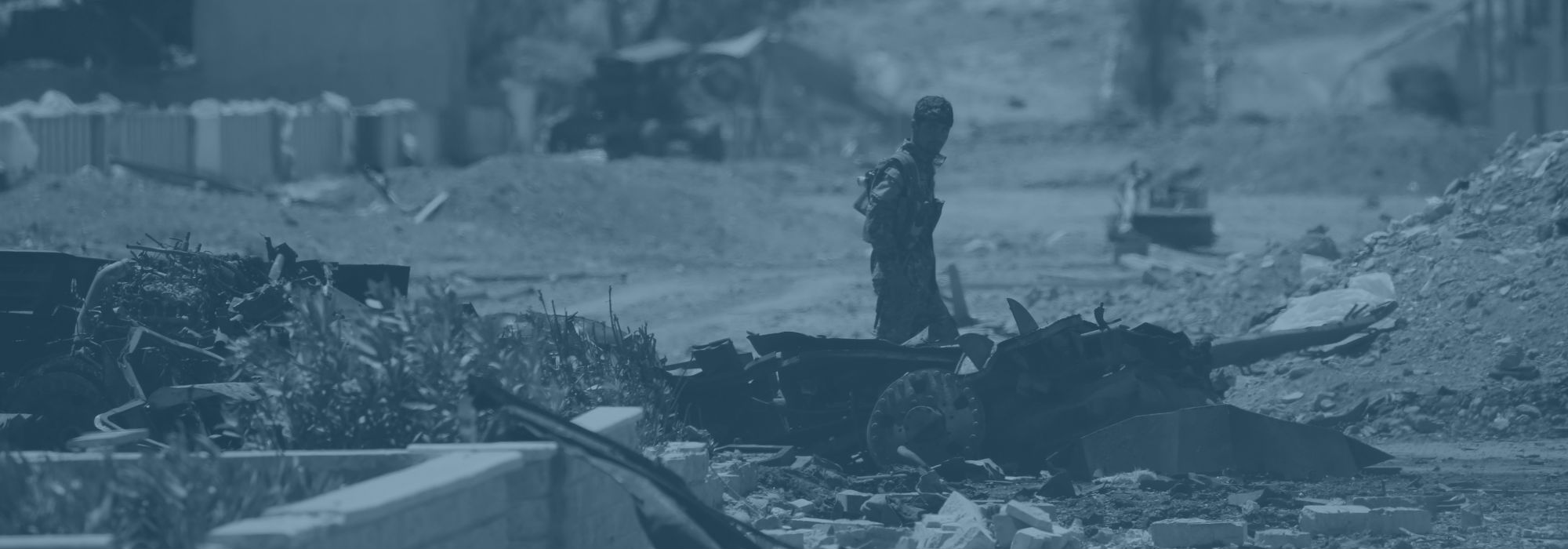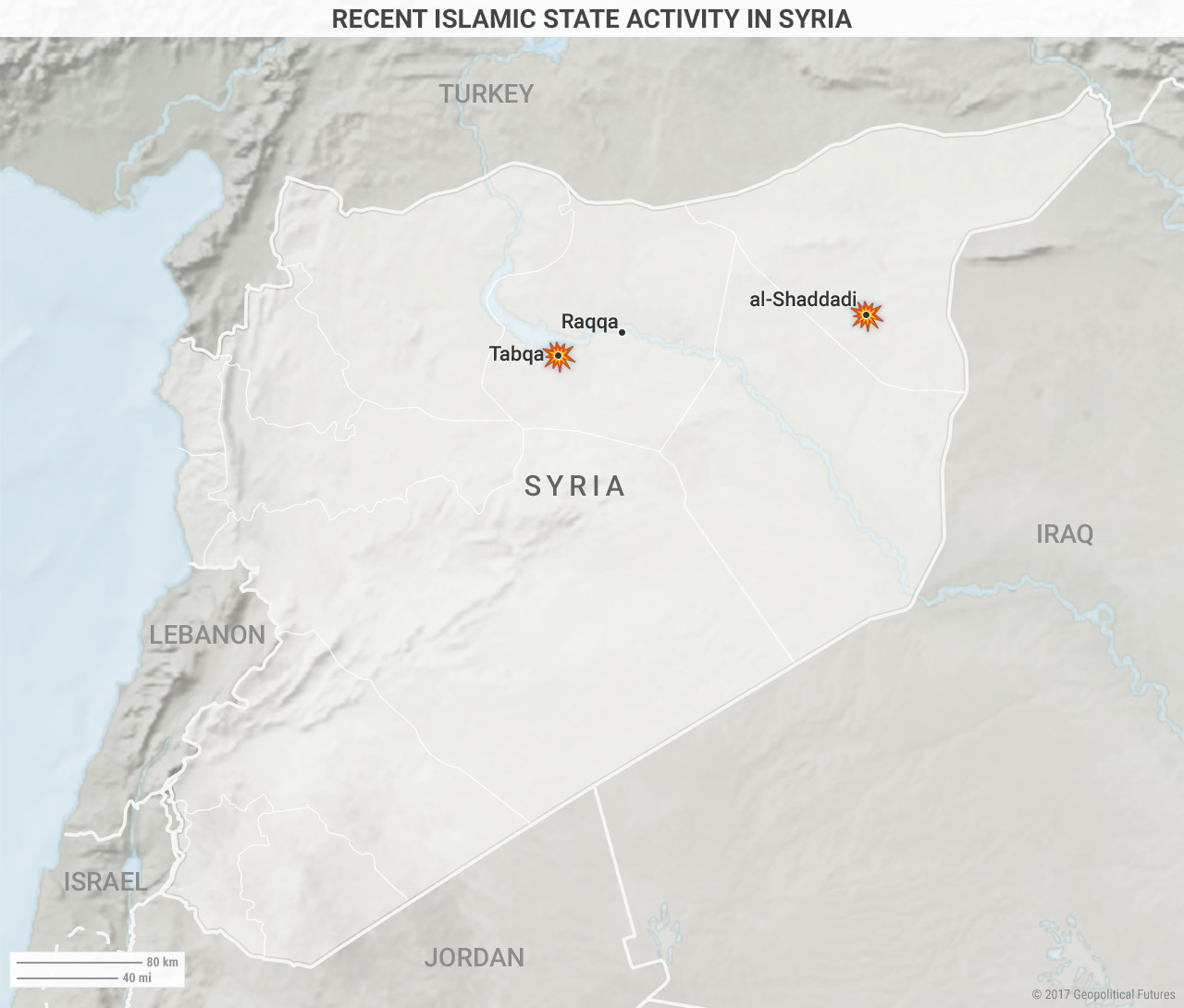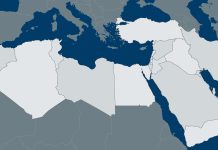Originally produced on May 8, 2017 for Mauldin Economics, LLC

By George Friedman and Jacob L. Shapiro
Two things happened in Syria over the past two weeks that went under the radar. First, US-backed Syrian Democratic Forces (SDF) claimed to have ousted Islamic State fighters from the last IS-controlled districts in Tabqa, a town 25 miles (40 kilometers) west of the Islamic State’s de facto capital, Raqqa. According to the Syrian Kurdish Hawar News Agency, IS fighters are now besieged at the Tabqa Dam outside the town.
Meanwhile, IS staged attacks in al-Shaddadi, roughly 125 miles east of Tabqa. Reports on casualty numbers are conflicting, but most suggest that around 40 people were killed.
North Korea may be the most pressing national security issue for the United States, but in Syria, the Islamic State remains a formidable enemy.
The US Approach to IS
After US President Donald Trump took office, he asked Defense Secretary James Mattis for a plan to defeat IS within 30 days. Mattis presented a preliminary plan in February, but no details were released at the time.
We can surmise, however, that Mattis told Trump something along the following lines: The US has bigger problems than IS, and the military has been fighting in the Muslim world for 16 years. Equipment needs maintenance, troops need reinforcements, and weapons need modernization. These changes cannot be made in 30 days. Besides, the US has a NATO ally in the region in Turkey and shares with Iran an interest in defeating IS. The US cannot be expected to be everything to everyone. Why not let Muslim countries deal with their own problems?
So far, that strategy has kept IS contained but has not hastened its downfall. The Islamic State conquered Mosul in two weeks in June 2014. Iraqi forces trained and supported by the US have been fighting to retake Mosul since October 2016. Although Mosul is not of vital strategic significance to IS, coalition forces have been trying to expel the Islamic State from the city for about seven months (14 times longer than it took IS to capture it)—and the battle isn’t over. Meanwhile, the SDF began its push to retake Raqqa with much fanfare last November. We predicted at the time that Raqqa would not fall in 2017, and that forecast is on track.
The developments in Tabqa and al-Shaddadi illustrate why we remain confident in our forecast. When the SDF attacked IS-held districts in Tabqa, many news outlets reported the SDF’s claims that it had ousted IS from the town as the gospel truth. But other sources were more discerning. The New Arab, for example, noted that Kurdish SDF fighters were negotiating a retreat with IS. The SDF did not conquer these districts but rather took possession of them after IS pulled back. IS chose to attack east of Tabqa in al-Shaddadi—which SDF fighters left undefended to focus on their objectives closer to Raqqa—and struck deadly blows where they were unexpected.
Reports on the IS assault in al-Shaddadi also varied. The Syrian Observatory for Human Rights and other sources described it as a suicide bomb attack targeting civilians. But the IS news agency, Amaq, said it was a more strategic assault. It said a small platoon of IS fighters, backed by heavy artillery and grad rockets, attacked four key points in al-Shaddadi, including an SDF checkpoint, inflicting severe damage.
We can’t judge which account is more accurate, but this was not an insignificant attack. It forces the SDF to make a choice: It can either continue its slow crawl toward well-defended Raqqa or pull back and defend positions that are vulnerable to an IS attack.
The struggle to defeat the Islamic State was a major topic of conversation during Trump’s phone call to congratulate Turkish President Recep Tayyip Erdoğan on his victory in last month’s referendum. The US wants Turkey to take the lead in destroying IS in Raqqa. Erdoğan has signaled that Turkey would be willing to work with a coalition of US and Russian forces to achieve this goal but that the Syrian Kurds, who make up the majority of SDF fighters, must be excluded. Thus far, the US has not acquiesced, pointing out that the SDF is bearing the brunt of the fight with IS.
IS Will Not Fade Away
North Korea will continue to dominate US attention, but the IS problem has not gone away. Erdoğan will visit the US in two weeks, and the disconnect between US and Turkish interests will be a hot topic. Trump, who praised Kurdish fighters while he was on the campaign trail, will face the same conundrum President Barack Obama encountered. The US does not want to abandon the SDF, both because of optics and because the group is a useful counterbalance to Turkish and Arab power in the region. But the US needs Turkey’s help to root out IS from Raqqa, and Turkey is using that to try to get the US to align with Turkish concerns about the Kurds.
Erdoğan does not want to go into the heart of the Syrian desert to fight IS any more than the US does. The Turkish military is in need of reorganization and modernization. Turkey has dipped its toes into the fighting in Syria but marching to Raqqa is orders of magnitude more challenging. Turkey is using its strategic position and the reputation of its military to try to exact concessions from the US and to manage its relationship with Russia. The great powers are playing chess, and only the pawns are in play right now.
The US may be preoccupied with other matters, but its attention will return to the Islamic State. A successful terrorist attack in the West, another chemical weapons attack in Syria, or unexpected territorial gains by IS could shift the world’s focus back to this conflict. But the Islamic State is biding its time, even when the world isn’t watching or has gotten tired of caring. IS has proved that it thinks strategically, fights tactically, and possesses patience beyond that of its enemies. Whether that is due to its religious devotion or the lack of alternatives is best left to psychoanalysts. What the geopolitical analyst can add is that the Islamic State is still behaving like a force that thinks it can win, and as long as the SDF is the only force fighting IS on the ground, that’s not an unreasonable assessment.








